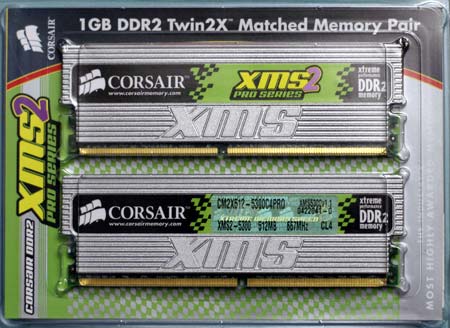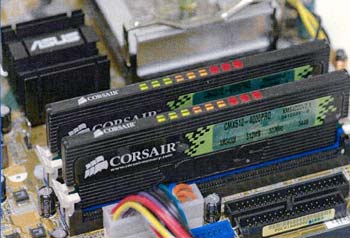DDR2 Roundup: Reaching for 667 and Beyond
by Wesley Fink on July 8, 2004 12:09 AM EST- Posted in
- Memory
Corsair XMS2 5300C4PRO
Corsair is well known as a producer of Enthusiast memory, so it came as no surprise that Corsair is first to market with DDR2 memory rated as the next standard of PC-5300 or DDR2 667. The timing of Corsair's introduction, however, was a bit of a surprise, just two weeks after Intel's introduction of the new DDR2 technology. With the difficulty of getting DDR2 to market, DDR2 667 was not expected to appear so quickly - especially at the aggressive 4-4-4 timings rather than the JEDEC 667 timings of 5-5-5.Test DIMMs were a matched pair of XMS2 PRO with the activity LEDs.

We first saw the LEDs in our review of Corsair XMS4000 PRO and again, in the review of Corsair DDR400 2-2-2 that was recently introduced. Corsair uses the PRO designation to indicate LED activity lights on the memory.

While Corsair did not reveal the manufacturer of the memory chips used in their new XMS2 667, we suspect that the memory is based on specially binned Micron DDR2 533 chips, which were introduced about two weeks ago. The performance across the board matches very closely to Micron and Crucial DDR2 memory tested in this roundup.
Test Results: Corsair XMS2 5300C4PRO
The full suite of benchmark tests were run at all memory speeds. This includes Quake3, Super PI, Sandra 2004 SP2 Memory Tests, Aida 32 Memory Tests, and Return to Castle Wolfenstein-Enemy Territory. We also ran UT2003, Aquamark 3, and Comanche 4 at every memory speed to verify stability of the reported memory timings. All benchmarks and additional tests had to complete without incident for the memory settings to be considered stable.| Corsair XMS2 5300C4PRO (DDR2 667) - 2 x 512Mb Double-Bank | |||||
| Speed | Memory Timings & Voltage | Quake3 fps | Sandra UNBuffered | Sandra Standard Buffered | Super PI 2M places (time in sec) |
| 533DDR 800FSB |
3-3-3-10 1.85V |
371.4 | INT 3196 FLT 3232 |
INT 4944 FLT 4945 |
107 |
| 667DDR 1000FSB |
4-4-4-10 1.85V |
458.0 | INT 3867 FLT 3898 |
INT 6170 FLT 6148 |
86 |
| 686DDR 258FSB |
4-4-4-10 1.85V |
471.7 | INT 3979 FLT 4022 |
INT 6322 FLT 6305 |
83 |
| Corsair XMS2 5300C4PRO (DDR2 667) | ||||
| Speed | RCW-ET Radar |
Aida 32 Read |
Aida 32 Write |
Aida 32 Total |
| 533DDR 800FSB |
78.4 | 5451 | 2280 | 7731 |
| 667DDR 1000FSB |
97.5 | 6627 | 2770 | 9397 |
| 686DDR 258FSB |
100.3 | 6836 | 2878 | 9714 |
Since there is no motherboard support at this time for a standard DDR2 667 memory, Corsair has programmed the SPD to 4-4-4-12 timings at DDR2 533. These are actually the rated timings for DDR2 667 performance. It is clear that XMS2 667 performs significantly better than 4-4-4 at 533, performing with faster 3-3-3 timings at 1.85V with no effort at the 533 speed. Corsair easily met the DDR 667 4-4-4 specifications at DDR2 667, at the same low voltage of 1.85V.
It is not surprising that the Corsair 667 had no problem running at the highest speed that the Abit AA8 currently supports at DDR2 686. Since this was accomplished at the same 4-4-4 timings and 1.85V, it certainly is logical to expect that the XMS2 667 is capable of even higher speeds than we can currently achieve on 925X motherboards.










20 Comments
View All Comments
betatest3 - Wednesday, August 18, 2004 - link
The DDR2 667 memory is allready available and price is around $245 to $270 for 512mb .The only memory I found was made by Crucial and some Generic by doing a search on pricewatch.com site The $245 memory can be seen here -->http://www.newegg.com/app/viewproductdesc.asp?DEPA...
Hmm.. this DDR2 memory was just made for Intel ??? or maybe in newer motherboards can be used with AMD also ? I would not think a newer memory made by many company's would just be designed for intel especially when alot of manufacturers are jumping over to AMD or can AMD use this 667 memory ?
jiulemoigt - Monday, July 12, 2004 - link
A very funny thought aquired to me after reading the older article on AMD's DDR2 stance. If their waiting for DDR2 667 and the memory is ready but quitly being called 533 does that mean AMD may actully be ready to pull a fast on Intel? Considering the way the chip is designed could the memory controller be flashed to update to the memory controller the same way the other frequencies are set? Oh and I would not buy a LGA socket the pin's being spring loaded just looks to be trouble :o cool articleWesley Fink - Friday, July 9, 2004 - link
FlameDeer -Good catch. P. 6 is corrected to 1032FSB.
FlameDeer - Friday, July 9, 2004 - link
Thanks for quick respond at #10, Wesley! :)Really appreciate your hours and hours of hard work to publish this very first hand thorough DDR2 roundup! :)
A quick look again of this good article, I noticed something need to ask. In page 7 till page 14, is that "258FSB" of 686DDR in every table mean 4 x 258 = "1032FSB"? And is this FSB related to page 6 settings no.3 of "1016FSB/DDR2-686"? Just curious, thank you! :)
pookie69 - Friday, July 9, 2004 - link
Cool - i think i understand that now.Thanks for replying and explaining. Appreciated :)
Wesley Fink - Friday, July 9, 2004 - link
The ratio is 3:4 looking at base clocks (200 to 266). The bus is then quad-pumped to 800 and memory is DOUBLE Data Rate or 533. I do agree it is a bit confusing since the final 800 ratio is 3:2 of the final DDR2 ratio (533).The 975/865 standard was 1:1 since the base clocks are 200, even though the final speeds were 800FSB (quad) and 400 DDR. It was never called 2:1.
pookie69 - Friday, July 9, 2004 - link
Nice article - good job :)Only one point; where it reads;
"This is currently slightly below the memory timing of 250 required to run memory at DDR2 667, at the standard 3:4 Intel memory ratio for DDR2."
>>> shouldn't that be a 3:2 ratio?
Or am i confused :S
Nice article again - keep up the good work Mr. Fink ;)
TrogdorJW - Friday, July 9, 2004 - link
I think a better conclusion might have been: And the winner is... NO ONE! (Or everyone, depending on whether you see the glass as half full or half empty.) While there are definitely measurable differences in performance between the various memories, reality is that only Quake 3 and Enemy Territory are meaningful benchmarks. Seeing that Quake 3 is one of the most bandwidth hungy games of all time, it's rather telling that a 15.4% advantage in Sandra only equates to a 2.7% performance difference in Quake 3 (and even less in W:ET). I'm not criticizing your work, mind you - just pointing out that the best case scenario of Sandra Unbuffered RAM tests are not the way we actually use our systems.At some point, it would be nice to see a memory roundup that included all the benchmarks that are used in CPU and graphics comparisons. Obviously, that wouldn't be a prudent use of your time when we're still being limited by the motherboard. However, in another six months, I would like to see a memory comparison put together that broadened the field of view in regards to benchmarks.
Great article, though. It will certainly be interesting to see how far each memory type can actually overclock when the motherboard is no longer the limiting factor. For the present, though, it looks like we might as well just save our pennies and buy cheaper DDR2 modules. (Not that any of them are actually "cheap"....)
Pumpkinierre - Thursday, July 8, 2004 - link
I suppose with all these new goodies, Wesley, you are going to give up on the excellent straight DDR articles you used to do.For the tRAS, the usual formula for DDR is: tRCD+CAS latency + 2 cycles, see:
http://www.mushkin.com/mushkin/pop-up/latencies.ht...
So that seems to work for DDR2 at tRAS >10. I dont know why DDR2 still works at tRAS of 4 though. I also dont know why nForce chipsets have their tRAS so high (10-12) on ordinary DDR.
You've got an engineering sample (multiplier unlocked) Prescott that o'clocks well. So you ought to do some tests at same CPU speed but different FSBs like you have done on the a64s. I know you might think it is stupid given that retail cpus are multiplier locked but some of us want to see whether it is better to put more money in a higher grade cpu or get a cheaper one and o'clock it high using more expensive high speed low latency memory. You had'nt done this with the N'wood/i875 memory tests either, but I cant remember whether you've got a good N'wood engineering sample lying around. Anyway just a suggestion.
ariafrost - Thursday, July 8, 2004 - link
Now if only DDR2 latencies were lower and the pricetag was less than DDR1 :)